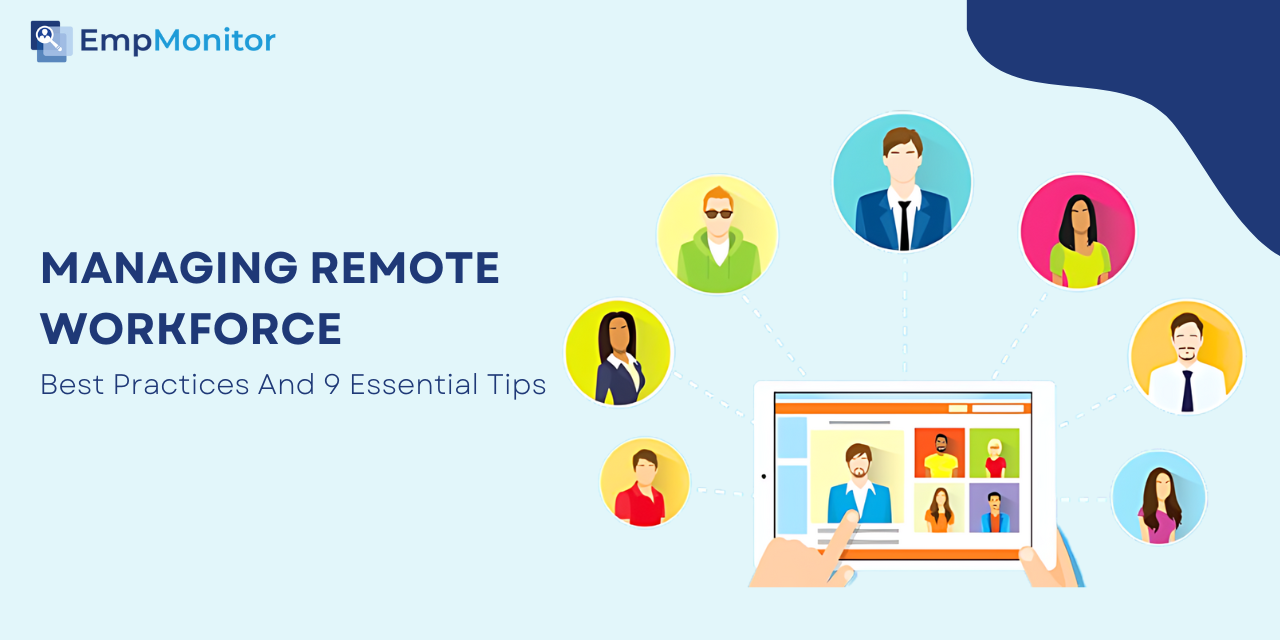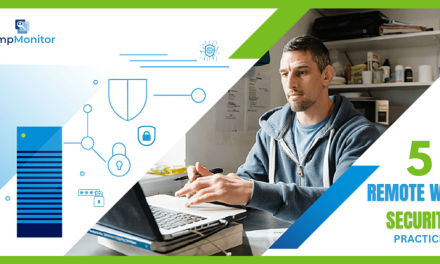As the landscape of work continues to evolve, the rise of remote work has transformed how businesses operate and teams collaborate. With technological advancements enabling seamless connectivity across distances, remote work has become not just a trend but a fundamental aspect of modern work culture. However, managing remote teams presents its own set of challenges, requiring managers to adapt their leadership style and implement effective strategies to ensure productivity, engagement, and success.
Whether you’re new to managing remote teams or looking to enhance your existing practices, the insights, and recommendations provided here will help you unlock the full potential of your remote workforce.
Let’s explore the principles and actionable strategies for managing remote workers in today’s dynamic work environment.
Listen To The Podcast Now!
Why Is Managing Remote Workers Important?
Managing remote workers involves supervising and coordinating employees across diverse locations, away from a traditional office setup. Tasks encompass setting clear expectations, maintaining communication, tracking productivity, providing resources, fostering collaboration, and ensuring employee well-being.
It is crucial for optimizing productivity, enhancing employee engagement, and fostering a cohesive work environment. When remote workers receive effective management, they are more likely to remain focused on their tasks, stay motivated, and meet deadlines. Moreover, engaged remote workers who feel supported and valued by their managers are more likely to be satisfied with their jobs and committed to the organization in the long term.
Effective management facilitates collaboration among remote teams, promotes open communication, and ensures regular performance monitoring and feedback. By investing in managing remote workers, companies can enjoy the benefits of remote work arrangements, including cost savings and flexibility, while maintaining high levels of productivity and performance across the organization.
Crafting Your Remote Work Strategy –
Developing an effective remote work strategy involves several key considerations to ensure productivity, communication, and employee well-being. Here’s a comprehensive approach:
Infrastructure and Tools:
- Communication Tools: Implement platforms like Slack, Microsoft Teams, or Discord for real-time messaging, video conferencing, and file sharing.
- Cloud Storage: Utilize platforms like Google Drive, Dropbox, or OneDrive for storing and sharing documents securely.
- VPN and Security Measures: Ensure that remote access to company resources is secure through VPNs, encrypted connections, and multi-factor authentication.
Clear Interaction Guidelines:
- Establish communication norms, such as response times for emails and messages.
- Set expectations regarding availability for virtual meetings and collaboration sessions.
- Encourage regular check-ins between team members and managers to maintain connectivity and provide support.
Flexible Work Policies:
- Define flexible work hours that accommodate employees’ schedules and time zones.
- Implement results-based performance metrics rather than focusing solely on hours worked.
- Offer guidance on setting up ergonomic home workstations to promote physical health.
Virtual Collaboration and Team Building:
- Organize virtual team-building activities like online games, virtual coffee breaks, or themed meetings.
- Promote a sense of belonging through shared interests and non-work-related discussions.
- Encourage cross-functional collaboration to maintain a sense of teamwork and unity.
Training and Support:
- Provide training sessions on remote work best practices, time management, and using collaboration tools effectively.
- Provide technical support for resolving remote access, software, and hardware issues.
- Regularly assess employees’ needs and provide resources to meet their professional development requirements.
Performance Management:
- Establish clear goals and objectives for remote employees, aligned with overall company objectives.
- Schedule regular performance reviews to provide feedback, address and solve remote work challenges, and recognize achievements.
- Encourage peer-to-peer feedback and recognition to develop a culture of continuous improvement and appreciation.
Employee Well-being:
- Prioritize mental health by promoting work-life balance and encouraging breaks throughout the day.
- Offer resources for managing stress, such as access to counseling services or mindfulness apps.
- Provide opportunities for social interaction and support networks within the organization.
Continuous Improvement:
- Solicit feedback from employees through surveys, focus groups, or one-on-one discussions.
- Regularly review and update remote work policies and procedures based on feedback and evolving needs.
- Stay informed about industry trends and best practices in remote work to adapt strategies accordingly.
Implementing these strategies helps organizations establish a remote work environment that promotes productivity, collaboration, and employee well-being.
How To Manage Remote Workers –
Managing remote workers requires clear communication, trust-building, and proactive leadership. Here is the following on how to manage remote workers:
Establish Clear Communication Channels:
Utilize various communication tools such as Slack, Zoom, or Microsoft Teams to maintain regular contact with remote workers. Clearly outline expectations regarding communication frequency and response times.
Set Clear Expectations and Goals:
Clearly define tasks, deadlines, and performance metrics to ensure remote workers understand their responsibilities. Align goals with organizational objectives to keep everyone focused and motivated.
Provide Adequate Training and Resources:
Provide remote workers with the essential tools included in the managing remote workers toolkit, training, and support to perform their roles effectively.
Ensure access to the technology and resources required for remote task completion.
Encourage Collaboration and Team Building:
Foster a sense of belonging and teamwork by organizing virtual team meetings, collaborative projects, and social activities. Create opportunities for remote workers to connect and build relationships with their colleagues.
Promote Flexibility and Autonomy:
Trust remote workers to manage their schedules and work environment efficiently. Offer flexibility in work hours and encourage autonomy in decision-making to promote productivity and job satisfaction.
The above shown ways can surely help you to manage your remote working employees. However, even when following the above ways and strategies, it would be quite challenging to monitor work patterns of remote workers. That’s why you need a remote workforce management solution like EmpMonitor, which allows you to keep track of your remote working employees without any hustle.
Best Practices For Managing Remote Workforce –
Implementing best practices can enhance your strategy for managing remote workers. Here are some vital practices to consider:
Establish Regular Check-Ins:
Schedule regular one-on-one meetings and team check-ins to discuss progress, address concerns, and provide feedback. Use video conferencing tools to maintain face-to-face interactions.
Promote Transparent Communication:
Encourage open and transparent communication within the team. Share updates, feedback, and important information through email, chat platforms, or project management tools.
Set Clear Performance Expectations:
Set well-defined goals and performance metrics for remote workers to track progress and success. Provide regular feedback on performance and offer support or guidance when needed.
Provide Opportunities for Growth:
Offer remote workers opportunities for professional development and advancement. Provide access to training programs, workshops, and mentorship opportunities to help them develop new skills and grow in their roles.
Develop a Positive Remote Culture:
Create a supportive and inclusive remote work culture by celebrating achievements, recognizing contributions, and promoting work-life balance. When managing remote workers, promote virtual team bonding activities and social events to cultivate unity among the team.
9 Essential Tips For Managing Remote Workers –
Managing remote workers presents unique challenges compared to traditional in-office settings. Here are nine essential tips for effectively managing remote teams:
Understanding Remote Workers Challenges:
Take time to understand the unique challenges faced by remote workers, such as potential feelings of isolation, communication barriers, or difficulties balancing work and personal life. By empathizing with their experiences, you can tailor support and solutions to better meet their needs.
Provide Regular Feedback:
Regular feedback is crucial for remote workers to grasp their performance and areas for improvement. It’s important to offer constructive feedback that is specific, actionable, and focused on helping them achieve their goals. Regular check-ins, performance reviews, and one-on-one meetings are great opportunities to provide feedback and guidance to remote workers.
Encourage Work-Life Balance:
Remote work can blur the lines between work and personal life, leading to burnout and decreased productivity. Encouraging remote workers to prioritize work-life balance by taking regular breaks, setting boundaries between work and personal time, and engaging in self-care activities can help them maintain their well-being and perform at their best.
Offer Support and Resources:
Remote workers may face unique challenges and obstacles, such as technical issues, lack of access to information, or feeling disconnected from the team. Employers should equip remote workers with the essential tools, resources, and support for their success. As seen in many outsourcing examples, access to proper training and communication tools can significantly improve performance and engagement. It may include access to software, equipment, training programs, and support from managers and colleagues.
Promote Collaboration:
Collaboration and teamwork are essential for remote teams to achieve their goals and stay connected. Employers can foster collaboration among remote workers by creating opportunities for them to share ideas, collaborate on projects, and support each other. It may involve using collaboration tools, scheduling regular team meetings, and promoting a culture of openness and collaboration.
Emphasize Communication:
Effective communication is Crucial for managing remote workers. Encouraging open and transparent communication among remote workers helps foster trust, alignment, and collaboration. Employers can promote communication by setting clear expectations for communication channels and response times, providing training on communication skills, and creating a culture where remote workers feel comfortable sharing their ideas and concerns.
Celebrate Achievements:
Recognizing and celebrating the accomplishments of remote workers helps boost morale, motivation, and team spirit. Employers can celebrate achievements by publicly acknowledging remote workers’ contributions, organizing virtual celebrations or awards ceremonies, and providing rewards or incentives for outstanding performance.
Provide Opportunities for Growth:
Offering remote workers opportunities for professional development and advancement helps them grow and thrive in their careers. It may include access to training programs, workshops, mentorship opportunities, and career advancement paths.
Providing growth opportunities benefits remote workers individually and also helps enhance the skills and capabilities of the entire team.
Also Read:
How To Solve Remote Work Challenges: 9 Effective Strategies
Managing Remote Workers Toolkit: The Ultimate Tools For Success
How To Make Staff Management Stronger?
Lead by Example:
As leaders, it’s essential to lead by example and demonstrate solid remote work practices. It means being accessible, responsive, and supportive of remote workers’ needs and concerns. By modeling behaviors such as effective communication, work-life balance, and collaboration, leaders can inspire and motivate remote workers to perform at their best.
Following the above tips can help you efficiently manage a remote workforce, ensuring productivity, collaboration, and team member satisfaction. Whereas you’re still facing problems in managing remote workers, relying on remote employee monitoring solution is a good idea. In such a case, you can use EmpMonitor, which offers a range of features to streamline workforce management. Let’s learn more about- how EmpMonitor can help you managing your remote workers.
Managing Remote Workers With EmpMonitor –
EmpMonitor is a software tool designed to help businesses monitor and manage employee activities, productivity, and engagement, particularly in remote work settings as it is a remote work monitoring software. Here are some key features and benefits of using EmpMonitor for managing remote workers:
Activity Monitoring:
It allows employers in monitoring and managing remote workers activities in real-time, including websites visited, applications used, and time spent on different tasks. It helps ensure productivity and accountability.
Time Tracking:
The software enables employers to track remote workers’ work hours and attendance, facilitating payroll management and compliance with labor regulations.
Screenshots and Screen Recording:
It captures screenshots or records screen activity at regular intervals, providing insights into remote workers’ work patterns and productivity levels.
Keystroke Logging:
Employers can monitor keystrokes to track remote workers’ typing activity, helping identify issues or inefficiencies in workflow processes.
Internet and App Usage Monitoring:
It tracks internet utilization and application usage, allowing employers to identify distractions and address productivity bottlenecks effectively.
Productivity Analysis:
The software provides detailed reports and analytics on remote workers’ productivity levels, enabling managers to identify trends, set benchmarks, and optimize workflows.
Remote Employee Engagement:
EmpMonitor includes features for remote employee engagement, such as messaging, task assignment, and collaboration tools, fostering communication and collaboration among remote team members.
Data Security:
EmpMonitor prioritizes data security and compliance, ensuring that sensitive employee information is protected and adhering to relevant privacy regulations.
EmpMonitor serves as a valuable tool for managing remote workers by providing visibility into their activities, promoting productivity, and facilitating communication and collaboration in a remote work environment.
Conclusion –
Effectively managing remote workers’ demands clear communication, transparent expectations, and ample support. Encouraging collaboration, promoting work-life balance, and recognizing achievements foster engagement and productivity. Leveraging tools like EmpMonitor enhances management by providing real-time monitoring and productivity analysis. By prioritizing communication, support, and performance tracking, organizations can navigate the challenges of remote work and maximize the potential of their distributed teams.

















